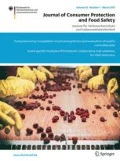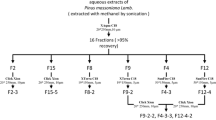Abstract
An innovative chromatographic process idea for preparative purification of rebaudioside A from aqueous extracts of Stevia rebaudiana Bertoni leaves is developed. The process can handle high concentrated aqueous extracts, needs less equipment and has a lower solvent consumption compared to the state-of-the-art purification process of rebaudioside A. The innovative process consists of a cascade of three preparative chromatographic columns. The first column separates steviol glycosides from the plant matrix using water as eluent in reversed phase mode. The fraction of steviol glycosides is then concentrated on a second column which works as a capture column with a more non-polar adsorbent. The last column separates rebaudioside A from steviol glycoside under normal phase conditions using a mixture of acetonitrile and water as eluent. With a total yield of 97.5 ± 1.5 % and a purity of 97.1 ± 1.5 % the process fulfills the legal requirements for the purity of rebaudioside A.












Similar content being viewed by others
References
Amtsblatt der Europäischen Union (2011) VERORDNUNG (EU) Nr. 1131/2011 DER KOMMISSION vom 11. November 2011 zur Änderung von Anhang II der Verordnung (EG) Nr. 1333/2008 des Europäischen Parlaments und des Rates hinsichtlich Steviolglycosiden (Text von Bedeutung für den EWR). L 295/205
Bergs D, Burghoff B, Joehnck M, Martin G, Schembecker G (2012) Fast and isocratic HPLC-method for steviol glycosides analysis from Stevia rebaudiana leaves. J Verbr Lebensm doi:10.1007/s00003-012-0760-5
Carakastos M, Curry L, Boileau A, Brusick D (2008) Overview: The history, technical function and safety of rebaudioside A, a naturally occurring steviol glycoside, for use in food and beverages. Food Chem Toxicol 46(7):S1. doi:10.1016/j.fct.2008.05.003
Crammer B, Ikan R (1986) Sweet glycosides from the stevia plant. Chem Br 22:915–917
EFSA (2010) Scientific opinion on the safety of steviol glycosides for proposed use as a food additive. EFSA J 8(4):1537
FAO (2010) Steviol glycosides. In: Joint FAO/WHO expert committee on food additives, compendium of food additive specifications, FAO JECFA monographs 10, pp 17–22
Hansen H (2010) Künftiger Einsatz von Steviolglykosiden. Ergebnisse einer Umfrage in der deutschen Getränkeindustrie. J Verbr Lebensm 5(2):237–239
Kienle U (2007) Stevia rebaudiana. Natürliche Süße im Behördendschungel. J Culin 5:59–69
Kienle U (2010a) Ein Naturstoff macht Karriere. J Verbr Lebensm 5(2):199–203
Kienle U (2010b) Welches Stevia hätten Sie denn gerne? Anbau und Herstellung - Perspektiven weltweit. J Verbr Lebensm 5(2):241–250
Klepsch A (2010) Stevia—Ante Portas! Aktuelle Rechtslage und Stand der Zulassungsverfahren. J Verbr Lebensm 5(2):211–212
Kohda H, Kasai R, Yamasaki K, Murakami K, Tanaka O (1976) New sweet diterpene glucosides from Stevia rebaudiana. Phytochemistry 15(6):981–983
Kovylyaeva GI, Bakaleinik GA, Strobykina IY, Gubskaya VI, Sharipova RR, Al’Fonsov VA, Kataev VE, Tolstikov AG (2007) Glycosides from Stevia rebaudiana. Chem Nat Compd 43(1):81–85
Kroyer G (2010) Stevioside and Stevia-sweetener in food: application stability and interaction with food ingredients. J Verbr Lebensm 5(2):225–229
María H, Enrique B, Raúl B, Joven J, Micol V (2010) Stevia is a source for alternative sweeteners: potential medicinal effects. Agro Food Ind Hi Tech 21(3):38–42
Schiffman SS, Sattely-Miller EA, Graham BG, Bennett JL, Booth BJ, Desai N, Bishay I (2000) Effect of temperature, pH, and ions on sweet taste. Physiol Behav 68(4):469–481
Wölwer-Rieck U (2012) The leaves of Stevia rebaudiana (Bertoni), their constituents and the analyses thereof: a review. J Agric Food Chem 60(4):886–895
Yang M, Hua J, Quin L (2008) High-purity rebaudioside A and method of extracting same (US 2008/0300402 A1)
Acknowledgments
The research was financially supported by the German Federal Ministry of Research and Education (Förderkennziffer: 0315663) and CLIB2021—Cluster Industrial Biotechnology.
Author information
Authors and Affiliations
Corresponding author
Rights and permissions
About this article
Cite this article
Bergs, D., Merz, J., Delp, A. et al. Preparative purification of rebaudioside A from aqueous extracts using chromatography: a process idea. J. Verbr. Lebensm. 7, 295–303 (2012). https://doi.org/10.1007/s00003-012-0784-x
Received:
Accepted:
Published:
Issue Date:
DOI: https://doi.org/10.1007/s00003-012-0784-x




